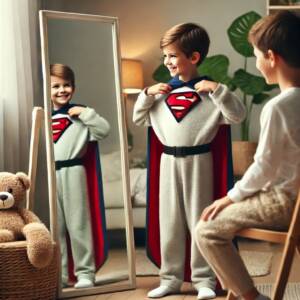
Sensory-Friendly Halloween Trick-or-Treating Tips

October 10, 2024
Trick-or-Treating Tips for a Sensory-Friendly Halloween
For many children, Halloween is a fun and exciting time. It’s a chance to bring pretend to real life and live out childhood fantasy. But as the parent of a child within the autism spectrum, you know Halloween can also be overwhelming for those with autism. Bright lights, loud sounds, and unfamiliar costumes can make the holiday a bit spooky in unexpected ways and cause sensory overload. However, with a few thoughtful adjustments, you can create a sensory-friendly Halloween that allows children with autism to enjoy the festivities.
At Learning ARTS, we deploy our EPIC Core Values of empowerment, impact, potential and compassion to everything we do as we try to create exceptional experiences for children within the autism spectrum. With these tips, you too can ensure Halloween is not only fun but also a positive experience for everyone involved.
Plan Costumes with Comfort in Mind 👗
 For children with autism, costumes with itchy fabrics or tight-fitting accessories can be more irritating than fun. When choosing or creating a costume, prioritize comfort over complexity. Look for soft, breathable materials and a comfortable fit – not too small or too big. And allow your child to have a say in what feels comfortable for them.
For children with autism, costumes with itchy fabrics or tight-fitting accessories can be more irritating than fun. When choosing or creating a costume, prioritize comfort over complexity. Look for soft, breathable materials and a comfortable fit – not too small or too big. And allow your child to have a say in what feels comfortable for them.
Some children may prefer minimal costumes, like a superhero cape, or even dressing up as their favorite character using everyday clothes. Or they may opt for something more elaborate – like dressing up as their favorite animal. Just remember, Halloween is about having fun, so let your child’s preferences guide the costume selection process.
Whether you are purchasing or making a costume, it’s a good idea to leave plenty of time for your child to practice wearing it. Ideally, you’ll schedule more than one practice session and allow enough time during each so your child can walk, play, and replicate some of the experiences they’ll have while trick-or-treating.
By involving your child in the decision-making process and allowing them to express their preferences, you are practicing our core value of empowerment because you are encouraging them to feel comfortable and confident in their Halloween attire.
Create a Sensory-Friendly Trick or Treating Plan 🍬 
With all the new sounds, smells, and activities, trick or treating can quickly become overwhelming to children within the autism spectrum. To prevent sensory overload, it’s helpful to plan ahead. Here are a few ideas for a sensory-friendly Halloween trick-or-treating experience:
- Start Early: Trick-or-treating earlier in the evening can help avoid large crowds and loud environments.
- Quiet Routes: Choose quieter neighborhoods or community events with sensory-friendly options.
- Consider Headphones: Even if you choose a quiet neighborhood, consider having your child wear headphones to reduce noise.
- Set Time Limits: Set a time limit for trick-or-treating so your child knows when the adventure will end.
- Overcome Language Barriers: If your child has a hard time initiating conversations or has limited language, be prepared to say “trick or treat” for them.
Understanding and addressing your child’s sensory needs demonstrates compassion and ensures they have a positive, enjoyable experience. By taking their needs into account, you help children within the spectrum feel safe and supported throughout the evening.
Practice Before the Big Night 🧙♂️
For children within the spectrum, surprises can trigger behaviors. To help ease anxiety and increase the potential for a fun evening, practice trick-or-treating before Halloween night. This can include role-playing the “knock and treat” scenario at home or walking around your neighborhood during the day to familiarize your child with the surroundings. Practice staying close, knocking on doors and role-playing the expected behaviors.
Another great way to prepare your child for trick-or-treating is to show them pictures of what to expect. You can just do an image search on Google or look for videos on YouTube that are specifically designed to help your child understand some basics about trick-or-treating.
Preparation ensures your child feels ready and confident, making a lasting positive impact on their overall Halloween experience. You’re not only making Halloween fun, but you’re also creating an experience that builds self-confidence.
Opt for Sensory-Friendly Treats 🍫
 While candy is a popular Halloween treat, many children within the spectrum or not, may have food sensitivities or preferences. You can provide alternative treats like small toys, glow sticks, or stickers for those who prefer non-edible options.
While candy is a popular Halloween treat, many children within the spectrum or not, may have food sensitivities or preferences. You can provide alternative treats like small toys, glow sticks, or stickers for those who prefer non-edible options.
Additionally, consider participating in the Teal Pumpkin Project, which promotes providing non-food treats for children with food allergies or sensitivities. By placing a teal pumpkin outside your home, you signal that your house offers alternative treats.
Offering sensory-friendly or alternative treats creates a space where every child can participate fully, realizing their potential for fun and joy, regardless of their dietary or sensory needs.
Create a Safe Space for Breaks 🏠
If your child feels overwhelmed, make sure they know it’s okay to take breaks. Whether it’s retreating to a quiet room at home or sitting in a calm spot while trick-or-treating, having a safe space to unwind can prevent meltdowns and help them reset. While it might be a good idea to schedule breaks, it is equally important to honor your child’s requests for impromptu break.
By providing a designated safe space for breaks, you empower your child to regulate their sensory input and respond to their needs with self-compassion (our favorite kind of compassion).
Have Realistic Expectations 🎃
 Finally, remember that Halloween doesn’t need to look the same for everyone. It’s okay if your child prefers to stay home, hand out candy, or watch their favorite Halloween movie instead of trick-or-treating. Setting and having realistic expectations ensures that the holiday is tailored to their needs and preferences.
Finally, remember that Halloween doesn’t need to look the same for everyone. It’s okay if your child prefers to stay home, hand out candy, or watch their favorite Halloween movie instead of trick-or-treating. Setting and having realistic expectations ensures that the holiday is tailored to their needs and preferences.
Compassion for your child’s unique preferences is key. Halloween is about creating joy, not pressure. Let them guide the experience in a way that makes them feel comfortable and included.
An Inclusive Halloween for All
With just a little preparation and understanding, you can create an inclusive, autism-friendly environment for Halloween that empowers your child to participate in a way that feels right for them. Whether it’s a cozy night in or a spooky night out, the goal is to have fun while making sure everyone feels safe, supported, and included.
At Learning ARTS, we’re committed to creating spaces where every child can reach their full potential—including a sensory-friendly Halloween full of fun!

About Author: Learning Arts
Formed by Dr. Will Brandon in 1997, Learning ARTS has been on a mission to be a leading force in autism therapy, pushing the boundaries of what’s possible and creating a brighter future for individuals within the autism spectrum, their families, and communities for nearly 30 years.
It is that experience that helps us understand that finding the right treatment for an individual within the autism spectrum can be overwhelming and confusing. But rest assured, when you choose Learning ARTS, you’re choosing a partner for your family’s autism journey. We offer a personalized, family-oriented approach to care that focuses on building relationships and social skills while providing access to community and classroom functions. Together, with our team by your side, your family will thrive.
